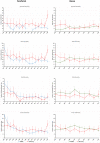Assessment of the consistency of health and demographic surveillance and household survey data: A demonstration at two HDSS sites in The Gambia
- PMID: 35830461
- PMCID: PMC9278757
- DOI: 10.1371/journal.pone.0271464
Assessment of the consistency of health and demographic surveillance and household survey data: A demonstration at two HDSS sites in The Gambia
Abstract
Objective: To assess whether an adapted Demographic and Health Survey (DHS) like cross-sectional household survey with full pregnancy histories can demonstrate the validity of health and demographic surveillance (HDSS) data by producing similar population structural characteristics and childhood mortality indicators at two HDSS sites in The Gambia-Farafenni and Basse.
Methods: A DHS-type survey was conducted of 2,580 households in the Farafenni HDSS, and 2,907 in the Basse HDSS. Household members were listed and pregnancy histories obtained for all women aged 15-49. HDSS datasets were extracted for the same households including residency episodes for all current and former members and compared with the survey data. Neonatal (0-28 days), infant (<1 year), child (1-4 years) and under-5 (< 5 years) mortality rates were derived from each source by site and five-year periods from 2001-2015 and by calendar year between 2011 and 2015 using Kaplan-Meier failure probabilities. Survey-HDSS rate ratios were determined using the Mantel-Haenszel method.
Results: The selected households in Farafenni comprised a total population of 27,646 in the HDSS, compared to 26,109 captured in the household survey, implying higher coverage of 94.4% (95% CI: 94.1-94.7; p<0.0001) against a hypothesised proportion of 90% in the HDSS. All population subgroups were equally covered by the HDSS except for the Wollof ethnic group. In Basse, the total HDSS population was 49,287, compared to 43,538 enumerated in the survey, representing an undercount of the HDSS by the survey with a coverage of 88.3% (95% CI: 88.0-88.6; p = 1). All sub-population groups were also under-represented by the survey. Except for the neonatal mortality rate for Farafenni, the childhood mortality indicators derived from pregnancy histories and HDSS data compare reasonably well by 5-year periods from 2001-2015. Annual estimates from the two data sources for the most recent quinquennium, 2011-2015, were similar in both sites, except for an excessively high neonatal mortality rate for Farafenni in 2015.
Conclusion: Overall, the adapted DHS-type survey has reasonably represented the Farafenni HDSS database using population size and structure; and both databases using childhood mortality indicators. If the hypothetical proportion is lowered to 85%, the survey would adequately validate both HDSS databases in all considered aspects. The adapted DHS-type sample household survey therefore has potential for validation of HDSS data.
Conflict of interest statement
The authors have declared that no competing interests exist.
Figures


Similar articles
-
Under-five mortality in The Gambia: Comparison of the results of the first demographic and health survey with those from existing inquiries.PLoS One. 2019 Jul 23;14(7):e0219919. doi: 10.1371/journal.pone.0219919. eCollection 2019. PLoS One. 2019. PMID: 31335884 Free PMC article.
-
Neonatal and child mortality data in retrospective population-based surveys compared with prospective demographic surveillance: EN-INDEPTH study.Popul Health Metr. 2021 Feb 8;19(Suppl 1):7. doi: 10.1186/s12963-020-00232-1. Popul Health Metr. 2021. PMID: 33557871 Free PMC article.
-
Comparing performance of methods used to identify pregnant women, pregnancy outcomes, and child mortality in the Iganga-Mayuge Health and Demographic Surveillance Site, Uganda.Glob Health Action. 2017;10(1):1356641. doi: 10.1080/16549716.2017.1356641. Glob Health Action. 2017. PMID: 28799450 Free PMC article.
-
Health & Demographic Surveillance System Profile: Farafenni Health and Demographic Surveillance System in The Gambia.Int J Epidemiol. 2015 Jun;44(3):837-47. doi: 10.1093/ije/dyv049. Epub 2015 May 6. Int J Epidemiol. 2015. PMID: 25948661 Review.
-
Health and demographic surveillance systems in low- and middle-income countries: history, state of the art and future prospects.Glob Health Action. 2021 Oct 26;14(sup1):1974676. doi: 10.1080/16549716.2021.1974676. Glob Health Action. 2021. PMID: 35377288 Free PMC article. Review.
Cited by
-
Impact of the COVID-19 pandemic on the coverage and timeliness of routine childhood vaccinations in the Gambia, 2015-2021.BMJ Glob Health. 2023 Dec 26;8(12):e014225. doi: 10.1136/bmjgh-2023-014225. BMJ Glob Health. 2023. PMID: 38148110 Free PMC article.
-
Under-5 mortality surveillance in low-income and middle-income countries: insights from two Health and Demographic Surveillance Systems in rural Gambia.BMJ Glob Health. 2024 Apr 2;9(4):e014937. doi: 10.1136/bmjgh-2023-014937. BMJ Glob Health. 2024. PMID: 38569661 Free PMC article.
-
Serological survey to determine measles and rubella immunity gaps across age and geographic locations in The Gambia: a study protocol.Glob Health Action. 2025 Dec;18(1):2540135. doi: 10.1080/16549716.2025.2540135. Epub 2025 Aug 20. Glob Health Action. 2025. PMID: 40833299 Free PMC article.
References
-
- Byass P. , Person, place and time—but who, where, and when? Scand J Public Health, 2001. 29(2): p. 84–6. - PubMed
Publication types
MeSH terms
LinkOut - more resources
Full Text Sources

